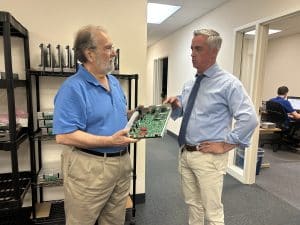The National Center for Educational Statistics (NCES) released their 2023 findings just as undergraduate and graduate students head back to campus – some of whom will suffer from hunger and homelessness.
The study, which dropped in July, “examines the characteristics of students in postsecondary education, with special focus on how they finance their education.” Their report centralizes data and quantifies the number of students who receive aid of any kind. It also details the type of aid received: Employer-based, state or federal assistance, veterans’ benefits, Pell grants – even how many students take out loans and the extent of that debt.
In Pennsylvania, the average college student has $42,243 worth of student loans. In a state with a median income of $32,156, that debt may take decades to pay back. While Bucks County median income is slightly higher at $41,559, repayment of student loans can place a permanent drag on the ability to provide for one’s self and their family.
READ: Bucks County Has Two Millionaires For Every One Homeless School Child
The National Postsecondary Student Aid Study details give a part of the story, but according to Philadelphia-based national authority on poverty and higher education, Sara Goldrick-Rab, it’s not the whole story. Goldrick-Rab has collected data for decades detailing life for students in poverty. Her findings show that funding for higher education is based on, “overestimating what students can pay and underestimating their costs.”
Goldrick-Rab took the NCES data, combined with information collected through an organization she founded, The Hope Center for College, Community, and Justice, and uncovered some staggering truths about poverty and education. The highlights include, “23 percent of undergraduates and 12 percent of graduate students experienced food insecurity,” amounting to more than 4 million students. Meanwhile, more than 1.5 million undergraduate and graduate students are experiencing homelessness.
According to Goldrick-Rab, this means, “A student who is in bad shape but not terrible shape,” answers yes to certain survey questions:
“I can not afford to eat balanced meals. I worry about my food running out before I have enough money to buy more. Sometimes I cut the size of my meals, or I skip meals because I don’t have enough money. This is the least awful but still qualifies as food insecure.”
And what’s worse about hungry students? Goldrick-Rab says they often answer, “I do all of that and my health has declined, and I go days without eating – that happens frequently.”
READ: Why Student Debt Cancellation Is Reasonable, Not Radical
Goldrick-Rab’s analysis shows that no demographic is immune to the adverse effects of poverty on individuals trying to get an education. White, Black, Native American, and Hispanic – all the numbers are staggering. Worst among them, more than one in three Black students have basic needs insecurity. And students at for-profit and private universities are worse off than those in public colleges.
Contrary to widespread public perception, food and housing insecurity are worse for students who work while attending school. Goldrick-Rab says people often ask her, “Are they just lazy?” Or they say, “Get a job.”
Goldrick-Rab counters, “They can’t because they are already working to mitigate the financial need [of college expenses].” In fact, Goldrick-Rab explained that the number of hours a person works is an indicator of how food and housing insecure that person is. “People working long hours in college are in really bad situations. You can’t work your way out of poverty in this country.”
But you can leave poverty behind by getting a better education. Earnings for college graduates are nearly double those of their lesser educated peers. Yet, for the poor, the barriers just get larger as President Clinton’s welfare reform “Work First” strategies deny more and more impoverished students an opportunity to advance themselves. Goldrick-Rab was a graduate student just starting her research when those early policies were implemented.
“All of these low-income women with children were told college wasn’t for them,” she said.
One of those women, Christina Hasaan, had her first child at 16. Born and raised in Philadelphia, Hassan finished high school and enrolled in a local community college but had to quit when she became pregnant with her second child. Two years later, she found herself pregnant with a third. “It’s so many people’s story and most people don’t end up where I am today,” she said. “It’s our circumstances, not who we are.”
Hasaan worked every job she could find to provide for herself and her growing family. “I worked fast food. Then I found a $10 per hour job in a lunchroom. I wanted to work near my kids. I got called out of work so much for my kids at school, I figured I may as well work there.”
READ: We Need To Recognize That Housing Is A Human Right
The enterprising and bright young woman was continually promoted in the school district. “I moved up from the lunchroom, to after school, to the front office, to assistant for school programming. I only had a high school diploma, no experience, but I knew how to build relationships. I figured if I worked hard enough and I’m good enough, I could keep going. But I hit a pay cap.”
Without a college degree, Hasaan could advance no further. Her lack of education became a wage trap. Hasaan enrolled at the Community College of Philadelphia (CCP) and later transferred to Temple University. CCP, and most other community colleges, have programs geared to non-traditional learners. After taking her first sociology class she knew what she must study. “It opened my mind. Why are our systems the way they are? Why do some people break through, and others do not?
Hasaan attended school year-round. She completed every hour of work-study allowed to her. She relied on family for childcare – a luxury she acknowledges other mom’s don’t have. She started a go-fund me when things got unbearable. She frequented the college food pantry. “The pantry was my best friend. The pantry allowed for my household size. Some pantries only allow for the student to have food.”
Hassan’s children are now 11, 13 and 15. Her life has changed. Married, and a college graduate, she’s no stranger to poverty, but hopes to have left it behind. Since her graduation in 2022, the young mom took a job as programs coordinator at the non-profit Swipe Out Hunger, helping students with food insecurity. She knows the sort of help people in search of an education really need. “I had lots of family support. Helping with the kids. I was fortunate to have their help. And I couldn’t have made it through without my husband.”
Goldrick-Rab’s work emphasizes Hasaan’s story. Her research illuminates the aftereffects of U.S. federal policy changes begun in the 1990s – policies that deny financial support to people in poverty who seek an education. Goldrick-Rab’s studies show that food and housing insecurity for the poorest students in the country is no accident. She contends that racist policy makers had an agenda for people like Hasaan who hit an income ceiling.
In the minds of those prejudiced politicians, “Christina isn’t supposed to go to college – she’s supposed to suffer in poverty while working minimum wage, it’s her place and station in life.”







